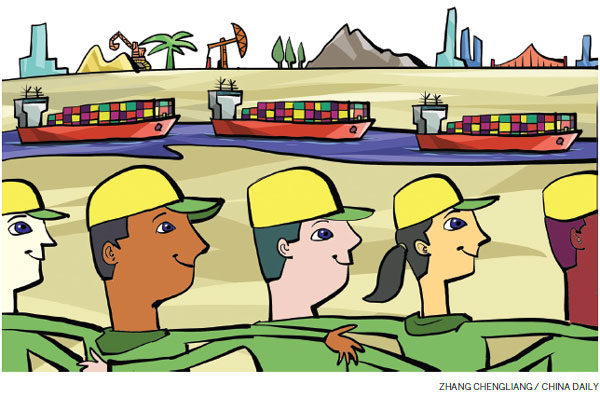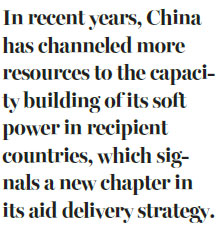China's aid approach gains momentum
China Daily Europe,October 19, 2017 Adjust font size:
Its foreign assistance model will continue to diversify and upgrade as nation takes on more responsibilities
The concept of foreign aid has attracted criticism since aid programs started to take shape and become a definite commitment in the 1960s, when the first humanitarian crises reached mass audiences on television.
Back then, the mainstream was in favor of trade rather than aid. Yet five decades have passed and the debate is still unsettled, as many of the prominent figures in development economics denounce foreign aid, labeling it as an act to undermine the development of local state capacity.

The most recent and eloquent bashing on foreign aid came from Angus Deaton. The Nobel Prize winner in economics, who studied how the poor decide to save or spend, argued that much of the $135 billion (113 billion euros; £99.6 billion) given away by the world's most developed countries in 2014 was not well spent on poverty alleviation. His fellow Nobel laureate Muhammed Yunus shares this concern and goes to great efforts to convince policymakers from the world's largest donors to revisit their countries' foreign aid strategies and opt for a more sustainable model, instead of simply giving handouts of food and checks.
The critique from economists and practitioners in the international development arena indicates that foreign aid should feature a self-sustaining pattern and stimulate growth. From this perspective, China's foreign aid model offers an alternative approach that could lift the concept out of its current predicament.
China's history of providing foreign aid could date back to the 1950s. Despite a modest start, China is now the largest developing country aid provider - the Organization for Economic Cooperation and Development countries remain the largest contributors to foreign aid. According to a policy paper issued by the State Council in December last year, China has given about 400 billion yuan ($61.64 billion; 51.95 billion euros; £45.65 billion) in development aid to 166 countries and international organizations over the past 60 years.

In fact, the most direct and remarkable change in China's foreign aid over the years is its expanded size and breadth. The OECD's international development statistics suggest that China's provision of foreign aid in 2001 was limited and only accounted for 1.8 percent of the total donation of OECD countries. However, the number rose to 6.6 percent in 2013, with an average annual growth rate of 21.8 percent. The latest official white paper on foreign aid, released in 2014, further elaborates that between 2010 and 2012, China provided 89.3 billion yuan in foreign assistance through grants, interest-free loans and concessional loans, making China the world's 10th-largest donor.
In addition, the number of countries to which China's foreign aid flows amounts to 92 across six geographic regions (Africa, Latin America, East Asia, the Middle East, South Asia and Central Asia). Africa and Asia still account for the lion's share of China's assistance. Africa accounted for 51.8 percent of the aggregate aid, according to the 2014 white paper. This is not surprising, since Africa is among the regions that are most in need of foreign aid, and China has longstanding ties with the continent. This trend has been strengthened since China established the Forum on China-Africa Cooperation in 2000. Asia comes second as China's foreign aid recipient, taking up 30.5 percent of the funding.
A swift change in China's aid program is its increased presence in Europe, as China funneled 1.7 percent of its total provision to developing countries in East Europe from 2012 to 2014. The amount stood at a modest 0.3 percent in 2009. Another change worth noting is that China's aid to the least-developed countries has risen from less than 40 percent to 52.1 percent between 2009 and 2012.
China's foreign aid policy is premised on equality of partners, mutual benefit and respect for sovereignty, with an emphasis on enhancing the recipient's self-reliance to nurture a sustainable development path, which reflects a win-win development equation. This forms a virtuous circle: The foreign aid helps foster economic growth pillars and improve the social well-being in low-income countries, which in return supports the recipient country's development in the long run. And given that the development pattern could sustain itself locally, it does not place unfair or additional financial burdens on the donor country's domestic taxpayers.
Another unique characteristic in the China foreign aid model is the country's commitment to an aid policy that comes with no strings attached. This is consistent with China's Five Principles for Peaceful Co-existence, a guiding principle for formulating broader foreign policies. China's respect for self-determination and national sovereignty in providing aid stands in stark contrast to the more widely adopted model in the West, in which aid is contingent on the recipient country's consent to embrace a free market or to build small government, clauses collectively known as"Washington consensus". China's practice protects the recipient country's interests and avoids potential disputes on governance.

China's foreign aid used to focus on hardware infrastructure construction, including the transportation, energy and communication sectors. In recent years, China has channeled more resources to the capacity building of its soft power in recipient countries, which signals a new chapter in its aid delivery strategy. As the 2014 white paper revealed, direct investment in infrastructure projects decreased from 61 percent before 2009 to 44.8 percent in 2012. In the meantime, China held 1,951 technical and on-the-job training sessions for almost 50,000 officials and technical personnel from poor developing countries.
Additionally, aid programs have surged in areas such as social services, food security, medical care, gender equality, disaster prevention and relief. For instance, China actively engages with global health diplomacy and has initiated a program that has transferred more than 3,600 Chinese doctors to teach and support local medical staff in more than 54 poor countries.
On the international security and disaster relief front, China has become an active player, dispatching more than 30,000 peacekeepers to nine conflicted countries and regions including Afghanistan, Congo, Haiti and South Sudan by 2016. Furthermore, President Xi Jinping pledged at the United Nations summit in September 2015 to establish the China South-South Cooperation and Assistance Fund. An initial $2 billion has been committed as a down payment; the fund is primarily designated to improving the general well-being of the citizens of recipient countries.
As one of the world's largest donors, the United States, threatens to cut its spending on foreign aid, reducing it by $17 billion in the 2018 federal budget proposal, China's significance in playing a more important role in international development stands out. And China is ready to take on more responsibilities under its Belt and Road Initiative, since President Xi committed $124 billion at the Belt and Road Forum for International Cooperation in Beijing in May to special lending programs, and it plans to channel almost $9 billion to food aid and poverty alleviation projects in the next three years in developing countries along the Belt and Road routes.
We can expect that China's foreign aid model will continue to diversify and upgrade, through the assistance of the Asian Infrastructure Investment Bank and other multilateral institutions initiated by the country, and through better governance, as President Xi has advocated that China should act more wisely in managing foreign aid to maximize the social gains.
The author is a director of Common Future, a Chinese NGO program for humanitarian aid for refugees. The views do not necessarily reflect those of China Daily.
(China Daily European Weekly 10/06/2017 page12)